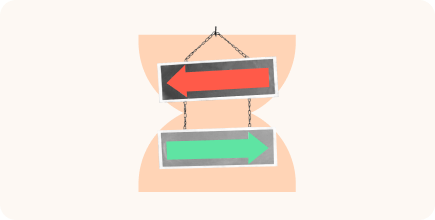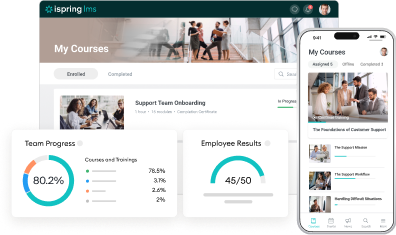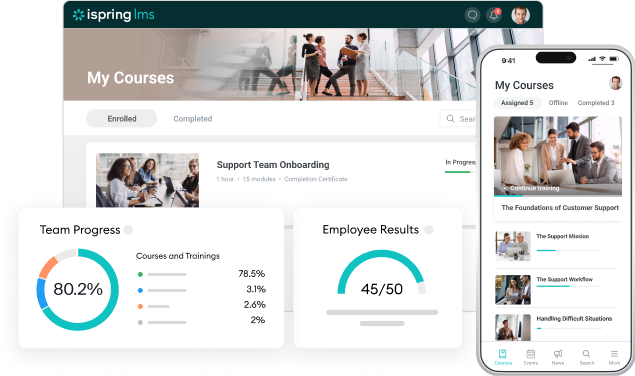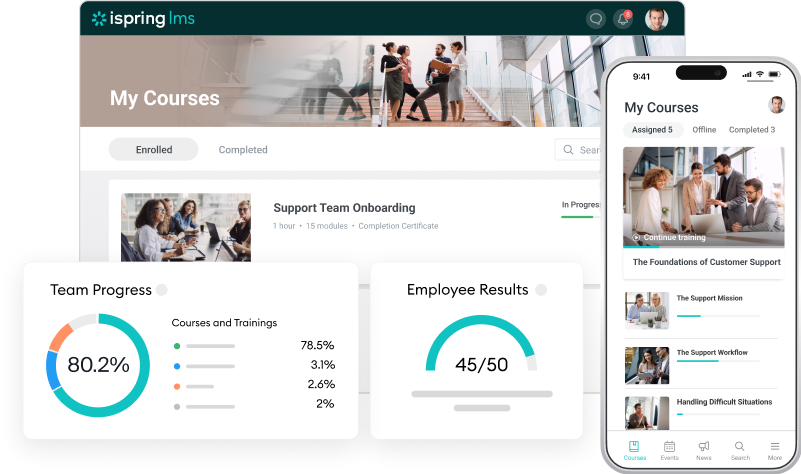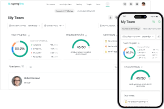How to Sell Courses on Shopify: A Guide for Companies and Individuals
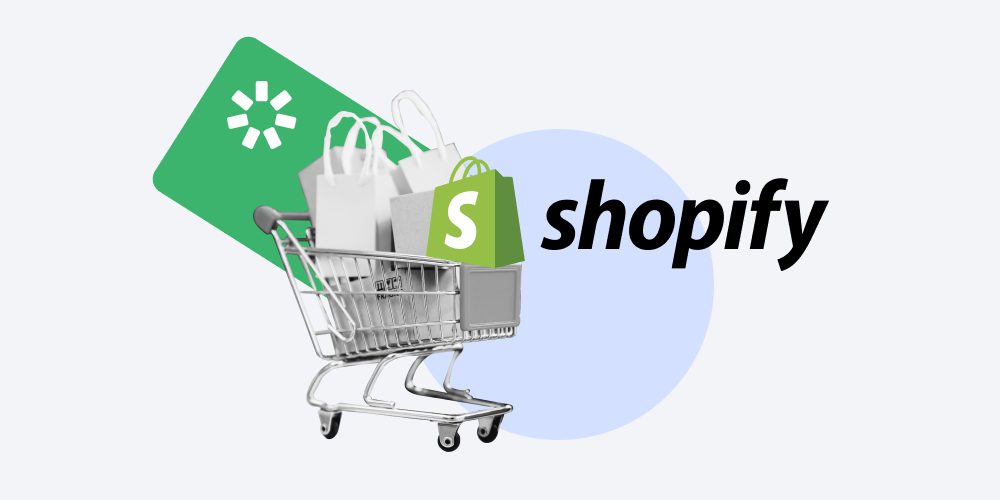
If you’re a course creator or an organization selling training courses online, you know how important it is to choose the right platform for selling your digital products. Is Shopify that platform? Maybe.
While giants like Udemy dominate the market, Shopify emerges as a powerful platform for selling not just tutorial videos but entire interactive learning experiences, subscriptions, memberships, and coaching services.
In this article, you’ll learn the benefits of selling courses on Shopify, the course formats that Shopify supports, and how to start selling your eLearning projects on this platform. Decide whether Shopify is the right platform for you, and if it is, discover our list of the 4 best Shopify apps you’ll need to launch your learning business.
Benefits of Selling Courses on Shopify
Why sell courses on Shopify and not, for example, on Udemy? First of all, these are two different learning universes. Udemy, Coursera, and similar ecommerce platforms have a large user base, which makes it easier to reach new clients. However, they are very limited in terms of course formats and tracking learner results. Basically, all you can do is sell video courses. It’s enough for many creators. But if you’re an organization that sells full-fledged interactive online courses to businesses or customer training programs, Shopify would be a better choice.
Here’s why:
The combination of eCommerce and eLearning
Shopify integrates with learning management systems (LMSs) and complements them. Your LMS empowers you to create online courses, host them, and track learners’ progress, while Shopify provides a platform for promoting and selling these courses. You’re not limited to tutorial videos. You can create more effective learning experiences, like scenarios, interactive modules, and assessments, which gives you a better competitive edge.
Robust marketing
Shopify comes with various digital marketing and SEO tools and apps, allowing you to reach your prospective customers, get to know them, and optimize your marketing efforts with detailed analytics. Whether it’s email marketing, social media marketing, or SEO optimization, you can promote your online courses to your audience effectively.
Clients from all over the world
With Shopify, you can sell online courses to people and organizations in more than 170 countries. There’s no need to worry about various taxes and other legal issues; the platform has this covered for you, so you can invest all your time and energy into creating top-notch courses and growing your business.
Brand control and customization
For creators or organizations with established brands, Shopify enables complete brand control. You can maintain your brand identity throughout the course purchase and learning experience, fostering brand loyalty among learners.
What Course Formats Can You Sell on Shopify?
Shopify offers flexibility in selling various course formats, allowing creators to deliver content in multiple ways. Here are some course formats commonly sold on Shopify:
Video courses
These are among the most popular formats. You can sell access to video lectures, tutorials, demonstrations, and presentations. Shopify allows you to embed video content or host it on external platforms while providing access to customers who purchase your courses.

Audio courses
For language learning, motivational content, or podcasts repackaged as learning resources, you can sell online courses as audio files or subscriptions. Users can stream or download the audio files after purchase.

Interactive courses
An interactive course is a high-quality course that may include quizzes, assessments, assignments, or interactive modules. Shopify allows selling access to these interactive elements as part of your course structure.

Ebooks and PDFs
You can also sell online courses in a text-based format, like guides, workbooks, and instructional materials in PDF or ebook formats. Customers can download these materials upon purchase.

Live webinars or workshops
You can sell access to live events, such as webinars or workshops, through Shopify by offering tickets or access passes. Integrating with third-party services for streaming or hosting live events is also possible.

Membership/Subscriptions
Shopify supports selling membership-based access to courses. Creators can set up recurring billing for ongoing access to course content or additional perks for subscribers.

Bundle packages
Course creators often sell bundle packages that include multiple online courses or supplementary materials. Shopify enables the creation of these bundled offerings for customers seeking a comprehensive learning experience.

Physical products
In some cases, physical products like workbooks complement the online learning experience. Shopify allows for the sale and integration of these physical items alongside digital course offerings.

Assessments and certifications
For online courses that include assessments, tests, or certifications, Shopify facilitates the sale of access to these evaluation components, allowing users to demonstrate their proficiency in a subject.

As you can see, Shopify is extremely flexible when it comes to course formats. However, you should keep in mind that it only works as your online store, meaning it’s a place where you sell online courses but not where you create and deliver them. For that, you will need an authoring tool and a learning management system.
How to Sell Courses on Shopify
A Shopify course store can bring you additional income and even become your primary source of income. To make this happen, you’ll need to conduct customer research, analyze the market, choose a course topic that is in high demand, and create online courses that your prospective customers will want to buy.
This might seem simple, but in reality, the success of your course selling business depends on multiple factors — from the quality of your online courses to your proficiency at marketing. For now, let’s focus only on the technical side of this process.
Here are the steps you need to take to start selling courses as a Shopify merchant:
Step 1: Set up your Shopify store
If you don’t have a Shopify account yet, create one and customize it. Select a theme for your online store and modify colors, fonts, and layout. Your online store should have an intuitive navigation and align with your brand identity.
Step 2: Add your online courses to Shopify
There are two ways to fill your Shopify store with courses: manually or automatically, by syncing Shopify with your LMS. The first one is applicable only to downloadable course materials, such as videos, PDFs, and PPT presentations. You won’t be able to monitor learner progress; customers will simply buy a file with your course. There’s also a risk that they will share it with other people. So, we recommend syncing Shopify with your LMS, since it allows you to provide better learning experiences, track results, and avoid such risks.
Way #1: Add courses manually
From the Shopify admin panel, click on Products and then Add product. Enter the course name and description, and add images. Set the price and choose the type of product (digital products). Then scroll to the Files section and upload your course materials. Repeat the same process for other courses.
Way #2: Integrate Shopify with your LMS
Not all LMSs integrate with Shopify, and those that do have different processes for setting up the sync of courses. So, if you already have a learning management system, find the necessary instructions and free resources on your vendor’s website.
Here’s how to sync up courses in iSpring LMS:
- Download the iSpring LMS app from the Shopify App Store.

- Enter the iSpring LMS account owner’s email and password. Then, enter the account’s domain. Click on Login.

- The Settings section will appear. Set the Default department and Default group fields to create new users in iSpring LMS.

- The Invitation text field is optional. Learners will receive an email notification that their account has been created, and they can create a password and sign in. If the Invitation text field is left blank, users will receive a notification with the default text.
- In the Default role field, specify the new user’s role. If no role is specified, new users will be assigned the Learner role.
- Next, click on Save. The Course synchronization page will then open. Choose which courses you want to sync, and click on Sync.

If you checkmark a folder, then all courses in that folder will be synced.
- Next, refresh the page. You will see the date and time of the last sync and its status.

And that’s it! Your courses for sale will now appear in your Shopify store.
Step 3: Configure sales and marketing
Once you have courses in your store, configure the payment gateway settings. Go to Settings and select Payment providers. Choose a payment gateway (for example, Shopify Payments or PayPal) and follow the steps to set it up.
Discover how to set the ideal course pricing in more detail.
Tips for better sales:
- Create promotions or discounts for your online course.
- Optimize the pages of your digital products with SEO-friendly descriptions and keywords.
- Set up email marketing campaigns.
Step 4: Test and launch
Before you start promoting your courses, make sure everything is working smoothly. Place a test order to see if all goes as planned and you (as a customer) receive access to online course materials after purchase. Fix issues if any arise.
Step 5: Optimize and grow
Nobody gets it perfect the first time. So, it’s essential to keep working on your courses and marketing strategies after the launch. Shopify and an LMS, like iSpring LMS, provide you with detailed analytics that show what works and what doesn’t — analyze it and make the necessary improvements.
Use the Analytics section in Shopify to track sales, customer behavior, and popular courses. Monitor which marketing strategies are most effective and adjust others accordingly (refine descriptions of your digital products, pricing, or promotions to improve sales).
And analyze progress reports in iSpring LMS to measure learner engagement and the effectiveness of your courses. For example, if most customers perform poorly during the final assessment, there might be an issue either with the assessment itself (like questions that are vague or misleading) or the online course content (for instance, you might need to highlight some key information or find a better way to present it if you see that learners don’t grasp it).
When your current offerings show stable, positive results, consider adding new courses, bundles, or supplementary materials based on customer demand.
The Best Shopify Apps for Selling Courses
In the Shopify app store, you can find multiple tools with various functions. However, for people who want to sell courses on Shopify, the most important thing is to select the LMS app that fits them best. That’s why we’ve test-driven dozens of LMS options that integrate with Shopify and compiled a list of the 4 best options:
- iSpring LMS
- Thinkific
- Teachable
- Teachery
Check out their descriptions and pros and cons to pick the one that’s perfect for you.
1. iSpring LMS

iSpring LMS is an intuitive all-in-one learning platform for creating, hosting, and delivering online courses, as well as tracking learner results. It integrates with Shopify directly, adding customers as users automatically after the purchase.
Thanks to customizable, detailed progress reports, you’re able to measure the effectiveness of your courses precisely and enhance them quickly and easily using the built-in authoring tool, iSpring Suite.

This tool empowers you to create interactive courses with scenarios, video modules, assessments, and other engaging learning activities that will make your courses stand out and sell better.
Pros
- Extremely easy to use thanks to a modern interface and smart features
- Learners can take courses on any device and even offline
- Comes with one of the world’s best authoring tools
- Supports multi-format lessons
- AI-powered online course creation
- Generates detailed learner progress reports
- Automates all tedious tasks, like creating user accounts for customers and sending them notifications regarding their purchase and learning process
- Keeps all your courses protected from theft
- Generates online course completion certificates
- 24/7 live technical support
Cons
- Doesn’t offer special pricing plans for individuals
- No xAPI, PENS, or LTI support
Pricing: starts at $6.64 per user/month, billed annually. A free 30-day trial is available.
Best for: training organizations and companies that want to use their LMS not only for training their team but also for training their customers on a paid basis.
2. Thinkific

Thinkific is an online course platform that allows you to build your own website, create and host courses, and track both learner progress and marketing metrics.
Compared to full-fledged LMSs, like iSpring LMS, Thinkific is less advanced in terms of designing learning experiences and analyzing their effectiveness. But if you’re not a professional eLearning developer and opt for something simple, Thinkific courses will be sufficient.
Pros
- Offers a free plan (limited to one course)
- Allows you to build your course website
- Easy to use
- Comes with an online course builder
- Provides technical support
Cons
- Doesn’t support any eLearning formats, like SCORM, xAPI, or AICC
- Only lets you build basic courses and assessments (without engaging content)
- Lacks customization options
- Limited tracking and marketing tools
Pricing: starts at $49 per month. There is a free plan that allows you to create and sell one course.
Best for: individuals (non-professional course creators) looking to monetize their expertise through selling online courses. For example, a guitar player who wants to earn extra income by teaching people how to play the guitar.
3. Teachable

Teachable is an online learning platform that’s similar to Thinkific but is more beginner-friendly. You can also create, host, and sell simple courses, as well as promoting them. Teachable has stronger marketing features but weaker course creation and website building. Still, it is pretty intuitive and covers most of the needs that aspiring course creators have, which makes it at least worth considering.
Pros
- AI-powered course curriculum development, quiz generation, and text-based course development
- Affordable pricing plans
- User-friendly interface
- Strong sales and marketing features
- A free plan with limited functionality is available
Cons
- Transaction fees for some plans
- Limited course creation, website building, and progress tracking features
- Doesn’t support eLearning formats
- Unstable workflow
Pricing: starts at $39 per month, billed annually. There is a free plan that allows you to create and sell one course at a 10% transaction fee.
Best for: aspiring course creators who don’t want to sell complex courses and prefer to focus on something simple.
4. Teachery

Teachery is an easy-to-use online course platform that prioritizes simplicity and affordability. This is both its main advantage and disadvantage. There are only two course templates available. You can’t add assessments or monitor learner progress. You can add video lessons, but can’t host them on Teachery. On the other hand, you get all of the platform’s features, from course creation to marketing, at the same price that other vendors offer their basic plans.
Pros
- Easy to use
- Low cost
- Covers all basic needs of course creators
- No transaction fees
- No limit on the number of courses or learners
- Excellent tech support
Cons
- Doesn’t allow you to build assessments or issue certificates
- Offers extremely limited course creation features
- Doesn’t provide you with learner progress reports
- Doesn’t support eLearning formats
Pricing: $49 per month or $470 per year.
Best for: a course creator who wants to keep things as simple as possible; an ecommerce entrepreneur who wants to sell digital products to earn extra income.
What You Can Do Right Now
Feeling inspired by the possibilities that Shopify offers for selling online courses? If you’re curious about maximizing your sales on this platform, explore iSpring LMS. Its seamless integration and robust features will help you stand out in this competitive industry, boost your sales, and foster customer loyalty.
Let’s talk about your ecommerce business and see exactly how iSpring LMS can enhance it. Book a free demo today.
FAQ
Can you sell coaching services on Shopify?
Yes, you can sell coaching services as well as sell courses on Shopify. However, you will need a third-party integration, like Teachable, to conduct coaching programs.
How profitable is selling online courses?
An ecommerce store of online courses can be a highly profitable online business if you have the right ecommerce platform, know your target audience, their learning needs, and create courses that they are willing to pay for. Course creators earn from $1,000 to $100,000 and more per year.
Is Shopify good for selling online courses?
In short, yes. However, it depends on many factors, including your market, target audience, and course formats. For instance, if you want to sell a series of video lectures on an academic subject, Coursera would suit you better, because that’s where most of your potential customers are. But if you’re a training organization that offers full-fledged interactive online learning to individuals and businesses, you’re better off selling courses on Shopify.


